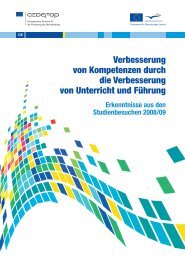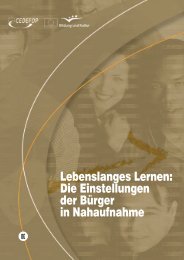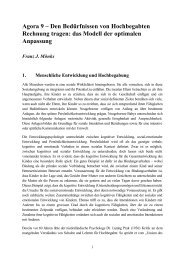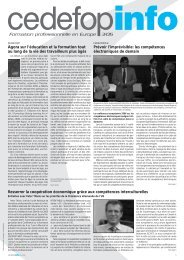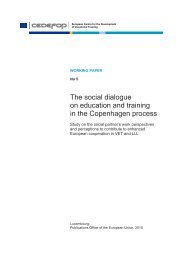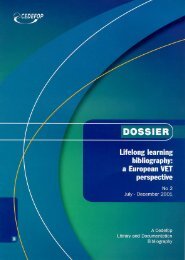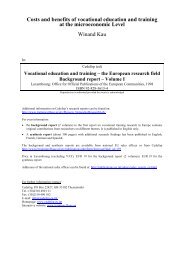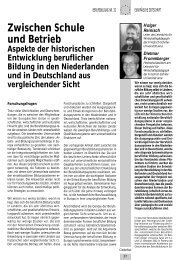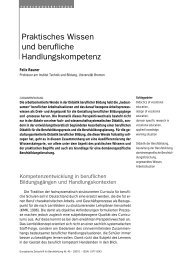Full text (pdf) - Cedefop - Europa
Full text (pdf) - Cedefop - Europa
Full text (pdf) - Cedefop - Europa
You also want an ePaper? Increase the reach of your titles
YUMPU automatically turns print PDFs into web optimized ePapers that Google loves.
198<br />
European journal of vocational training<br />
No 42/43 – 2007/3 2008/1<br />
lated - it will be possible to devise an integrated system of credit points within<br />
the foreseeable future, because otherwise two credit systems would coexist<br />
within a single qualifications framework.<br />
Over and above such technical questions concerning the composition and<br />
allocation of credits, questions need to be asked about the role of credit points.<br />
ECTS is not as coherent in its application as it is on paper. So far there is no<br />
empirical basis for the award of credit points. We shall now present a few incongruities<br />
in order to illustrate the difficulties:<br />
for example, some German universities still use weekly hours per semester<br />
rather than student workload as a basis for calculating credits; weighting<br />
is still applied in certain cases. Other universities conduct extra intermediate<br />
and final tests in addition to academic examinations (DAAD,<br />
2004). They award more credit points for labour-intensive courses than<br />
for courses merely requiring attendance. Matters become problematical<br />
when no common yardstick exists even within one institute or discipline<br />
(Rehburg, 2005);<br />
ECTS is an intricate system with credit points but also necessitates considerable<br />
administrative effort, red tape and an increased tutor workload;<br />
this impinges on the quality of teaching and, for students, means fewer<br />
choices and less autonomy during their studies;<br />
credit points provide no guarantee that credits obtained abroad will be fully<br />
recognised. There is no automatic administrative procedure for students<br />
to follow; examinations are held in individual cases (Rehburg, 2005);<br />
difficulties persist over the recognition of credits (for about 50 % of mobile<br />
students) and the dual testing of learning outcomes (in the form of credits<br />
and of the customary examination procedures). There is incorrect use<br />
of ECTS: ‘misunderstanding of student workload and diverse concepts of<br />
“modules”’ (Purser, Crosier, 2007b).<br />
Experience and difficulties with ECTS must be taken into account when<br />
applying ECVET, above all in terms of awarding and calculating credit points.<br />
Moreover, it is doubtful whether the ECTS system as it stands is transferable<br />
to VET and lifelong learning. The approach based on workload and learning<br />
outcomes has its justifications, but the compatibility of both parts of the<br />
system must be ensured: a credit certifies nothing other than the fulfilment<br />
of a requirement, which is only meaningful in connection with both the level<br />
of the anticipated learning outcomes (in relation to qualifications frameworks<br />
or systems) and the period of time within which these learning outcomes<br />
are expected (credit points). This would argue in favour of ECVET and ECTS




